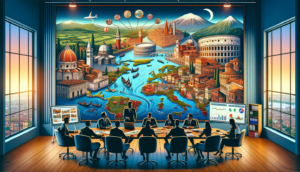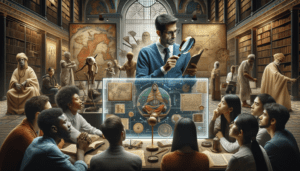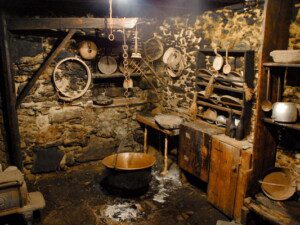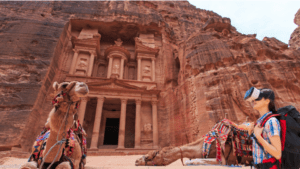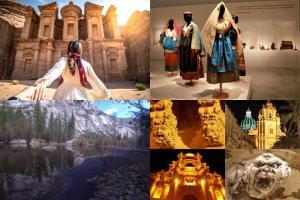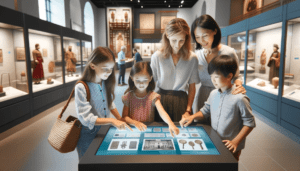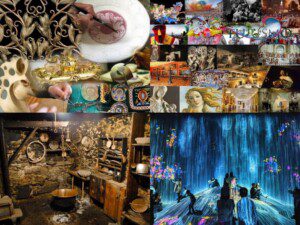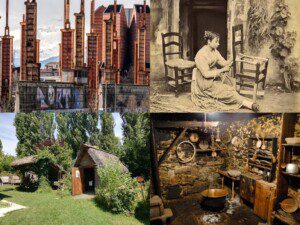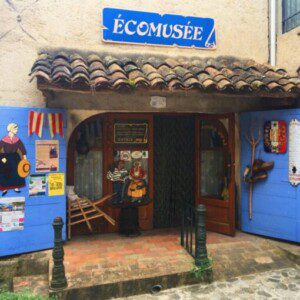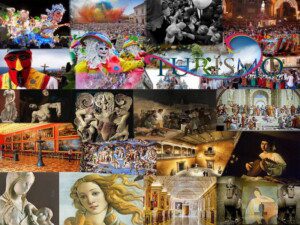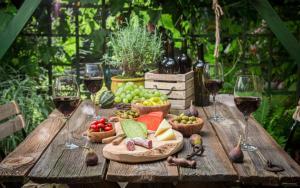The VQCEIP/QEcomusei methodology for the assessment of ecomuseum quality
Beta version
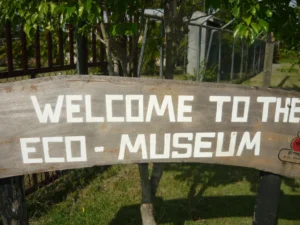
Premise
The VQCEIP/QEcomusei method is nothing more than the method VQCEIP, integrated with the additional requirements associated with Ecomuseums.
The VQCEIP/Ecomuseums self-assessment scheme is made available to all ecomuseums who wish to measure their organizational capacity in providing cultural heritage interpretation experiences.
To identify the additional requirements, let's start from the ecomuseum indicators that we have seen are:
Ecomuseum (what, who, for whom, with whom, where, how, why)
- Cultural heritage (what)
- Community (who, for whom, with whom)
- Territory (where)
- Participants (for whom)
- Interpretation (as)
- Accessibility (how)
- Enhancement
- Protection (why)
- Sustainable local development (why, how)
- Institution (who)
The additional requirements for ecomuseums are divided into four thematic areas, each of which takes into account one or more of the ecomuseum elements:
- Use, Enhancement and Protection of Cultural Heritage (1, 3, 5, 6, 7, 8)
- Community and Participation (2, 4)
- Sustainable Development of the Territory (9)
- Institution (10)
To avoid unnecessary redundancies, the requirements that have already been dealt with in the general VQCEIP scheme are not included, which must in any case be considered an integral part of the VQCEIP/QEcomusei scheme. For the same reason, requirements relating to Interpretation (5) are not included as they are included in the basic scheme VQCEIP.
It may be useful to understand the requirements presented by reading the article: Ecomuseum indicators
VQCEIP/QEcomusei scheme
|
|
Requirements (Beta Version) |
|
PC |
Fruition, Enhancement and Protection of Cultural Heritage |
|
PC1 |
Has the organization implemented initiatives to promote and enhance local identities? |
|
PC2 |
Has the organization established a permanent documentation center to publicize local identities? |
|
PC3 |
Has the organization set up a permanent exhibition center to promote local identities? |
|
PC4 |
Has the organization planned cultural and/or entertainment initiatives that revive or illustrate aspects related to local identities? (temporary exhibitions, reconstructions of environments, historical and work events, etc.) |
|
PC5 |
Does the organization plan heritage interpretation experiences in the field in direct contact with local identities? (excursions, guided tours, self-managed itineraries, etc.) |
|
PC6 |
The organization foresees paths of mediated interpretation which sees the use of paper and multimedia tools (panels, cards, flyers, websites, multimedia supports, etc.). |
|
PC7 |
Has the organisation, in organizing fruition itineraries and cultural events, implemented actions to protect the cultural heritage and the environment involved? |
|
PC8 |
Has the organization implemented policies and strategies that encourage and facilitate the use of the itineraries and the participation in the initiatives of the residents? |
|
PC9 |
Does the organization foresee initiatives that see the direct involvement of the community in the activities? |
|
|
|
|
CP |
Community and Participation |
|
CP1 |
Does the organization make available and make it accessible to the community a list where all the actors of the local community involved are defined? |
|
|
Does the local community involved include the following actors? |
|
CP2 |
Public institutions? |
|
CP3 |
Experts, researchers and scholars of the cultural heritage of the territory concerned? |
|
CP4 |
Entrepreneurs, artisans and businesses in the tourism and cultural sector? |
|
CP5 |
Cultural and cultural heritage protection associations? |
|
CP6 |
Residents and other stakeholders? |
|
|
The type of participation and involvement of the local community includes:
|
|
CP7 |
Information Sharing. Note: The information shared may concern decisions that have already been made or decisions that you intend to take.
|
|
CP8 |
Consultation. Note: The information is provided in order to gather opinions which will be used by the ecomuseum governance to make decisions.
|
|
CP9 |
Concertation Note: Information is provided through public debates aimed at the community and the results of the debates are, in substance and/or form, actually used by the ecomuseum's governance to make decisions.
|
|
CP10 |
Codecision Note: The community participates directly in the final decisions |
|
CP11 |
Is a community pact present and made public? |
|
CP12 |
Has a community map been implemented? |
|
CP13 |
Does the community map include sharing tools, interactivity, or other tools that facilitate dynamic community engagement? |
|
CP14 |
Public meetings open to community participation are planned and implemented) |
|
CP15 |
Are there strategies and policies in place to facilitate access to the activities and experiences of interpretation to the local community? |
|
CP16 |
Are there strategies and policies that stimulate direct participation in the activities and experiences of interpretation by entrepreneurs, craftsmen and businesses in the tourism and cultural sector as well as other interested parties? |
|
SV |
Sustainable development of the Territory
Note: The requirements related to Sustainable Quality have been taken into account in the VQCEIP basic scheme
|
|
SV1 |
Are there strategies, policies and activities in the area that lead to new skills or in any case to improve and update existing skills? |
|
SV2 |
If present, the Ecomuseum Quality Evaluation Unit made up of all the components indicated in the community pact which also evaluates the aspects linked to the sustainable development of the territory? |
|
SV3 |
Has an analysis been made that takes into account how ecomuseum activities can positively influence the development of the territory?. |
|
SV4 |
Do the strategies and policies adopted by the Ecomuseum take into account the analyzes carried out in the previous point? |
|
|
|
|
|
|
|
IS |
Institution
|
|
IS1 |
Is there an ecomuseum statute that clearly defines its mission and ecomuseum objectives?
|
|
IS2 |
Is there a regulation that clearly defines the functioning and the relationships between the partners of the ecomuseum?
|
|
IS3 |
Is there an Ecomuseum Quality Evaluation Nucleus made up of all the components indicated in the community pact?
|
|
IS4 |
There is an Ecomuseum Quality Evaluation Nucleus made up of all the members indicated in the community pact |
|
IS5 |
There is a Technical-Scientific Committee |
|
IS6 |
Where there is regional legislation for the recognition of ecomuseums, is the institution present in the list of recognized ecomuseums? |
A training course has been prepared for those who wish to do so, which can be useful for those who wish to learn more about the topic relating to the Evaluation of Ecomuseum Quality: SPE117: Assessment of Ecomuseum Quality (26 hours)
The course is also recognized by the Italian Association of Tourism Professionals and Cultural Operators (AIPTOC) authorized by Ministry of Economic Development (MISE) to release Certificate of quality and professional qualification of the Services pursuant to Articles 4, 7 and 8 of Law 4/2013.
Bibliography:
- UNI EN ISO9001 "Quality Management Systems"
- UNI ISO 20121 "Sustainable event management systems"
- Lighthouse Convention
- Heritage Interpretation Centres: The Hicira Manual
- Freemn Tilden – Interpreting Our Heritage – 2019 English Edition – Geographic Library
- Beck, T. Cable, Interpretation for the 21st Century. Fifteen guiding principles for interpreting nature and culture. Sagamore Publishing, 1998.
- Riccardo Pagano: Education and Interpretation - Profiles and categories of a hermeneutic pedagogy. Brescia – 2018
- HeriQ – Quality Heritage Interpretation
- InHerit Introduction to the professional development of Natural and Cultural Heritage Interpretation
- Franco Bianco: Introduction to hermeneutics - Laterza 1998
- Pine and Gilmore: The Experience Economy: Beyond Service -1999-2013
- Hugues De Varine: The singular and plural ecomuseum – Concrete Utopias -2021
- John A Veverka: Interpretive Master Planning Volume One: Strategies for the New Millennium museums etc.
- John A Veverka: Interpretive Master Planning Volume Two: Selected Essays Philosophy, Theory and Practice
- Quality, Operating Models and Competitiveness of the Tourist Offer (Ed. 2019) by Ignazio Caloggero. Helios Study Center Editions ISBN: 9788832060034
- Bloom, BS (Ed.), Engelhart, MD, Furst, EJ, Hill, WH and Krathwohl, DR Taxonomy of Educational Objectives: Handbook 1: Cognitive Domain. (1956)
- Anderson, LW, Krathwohl, DR (Eds.) A Taxonomy for Learning, Teaching and Assessing. A Revision of Bloom's Taxonomy of Educational Objectives. (2001)
- Joseph Pine, James H. Gilmore: The Experience Economy. Beyond the service – Etas 2000, Rizzoli 2013
- David Allen Kolb: Experiential learning: experience as the source of learning and development – New Jersey 1984
- Sam H. Ham. Environmental Interpretation: A Practical Guide for People With Big Ideas and Small Budgets – 1992
- Sam H. Ham, Ph.D. Can Interpretation Really Make a Difference? Answers to Four Questions from Cognitive and Behavioral Psychology. Sam H. Ham, Ph.D. Can Interpretation Really Make a Difference? Answers to Four Questions from Cognitive and Behavioral Psychology. Vancouver, Canada March 25-29, 2007.
- A Manual for Interpreting Community Heritage for Tourism; Canadian Universities Consortium Urban Environmental Management Project, 2000
- The Charter of Siena
- Manifesto of the Italian Ecomuseums
- Recommendation concerning the protection and promotion of museums and collections, their diversity and their role in society (UNESCO 2015)
- Ecomuseum Charter of Catania
- Ignazio Caloggero: Experiential Paths and Interpretation of Cultural Heritage Vol. 1: Origins and Theoretical Principles – Helios Study Center Editions – 2022
- Maurizio Maggi, Cecilia Avogadro, Vittorio Falletti, Federico Zatti: Ecomuseums. What they are, what they should become (Ires Piemonte -2000)
Featured training
Basic courses
Thematic courses on the Design of Experiences
Courses with Professionalizing Certification pursuant to Law 4/2013


